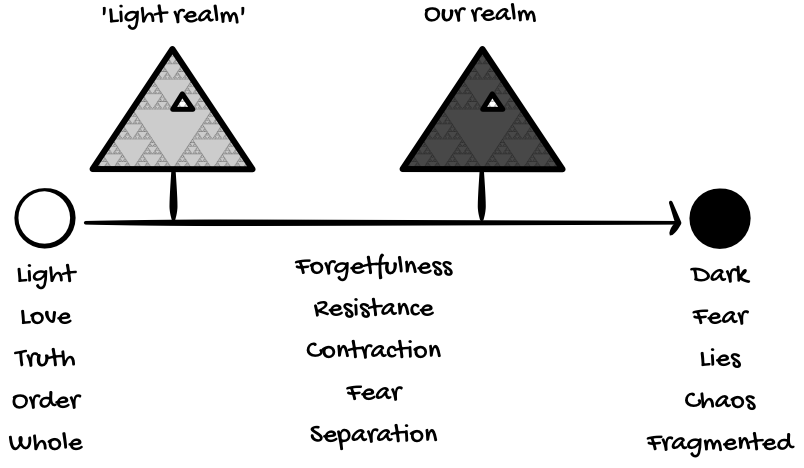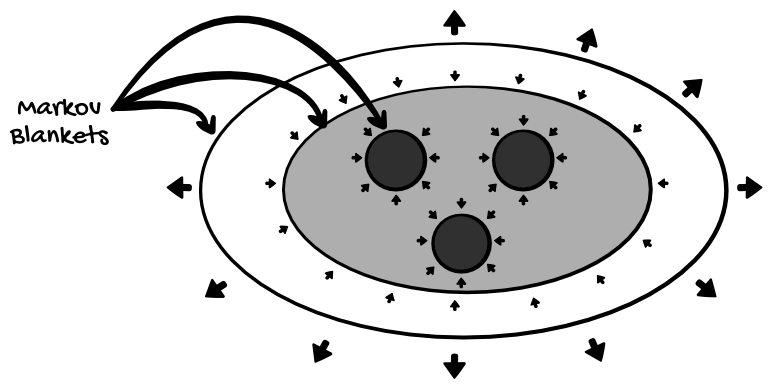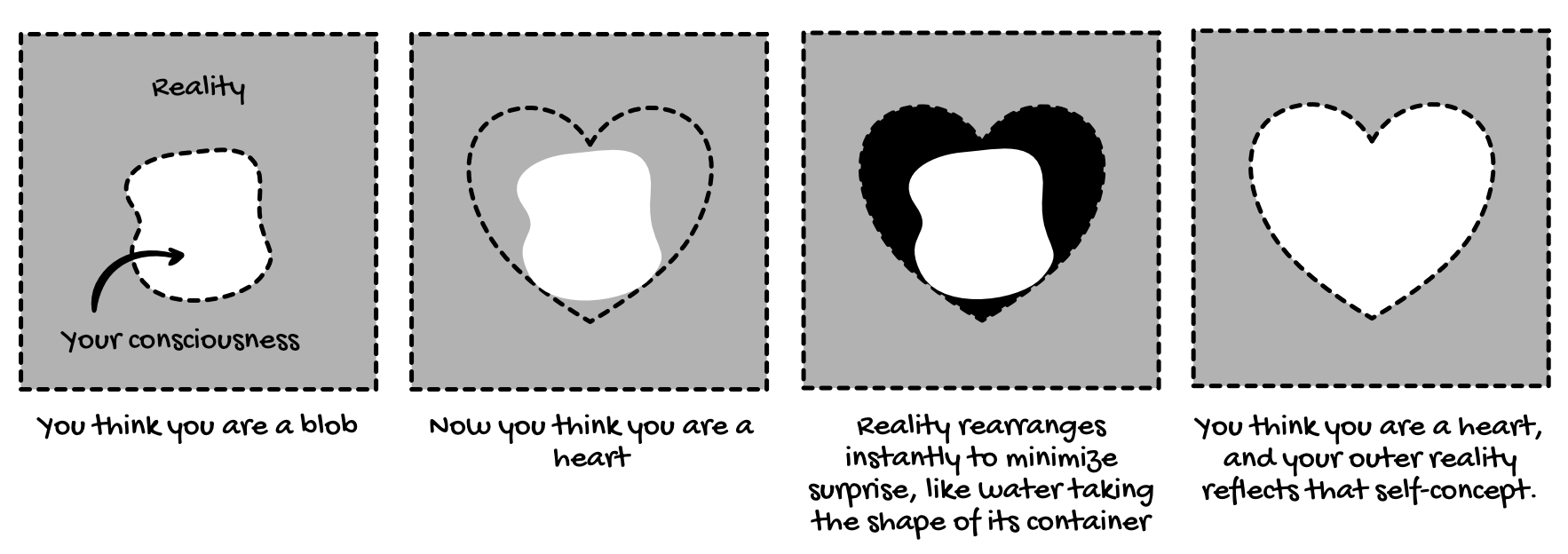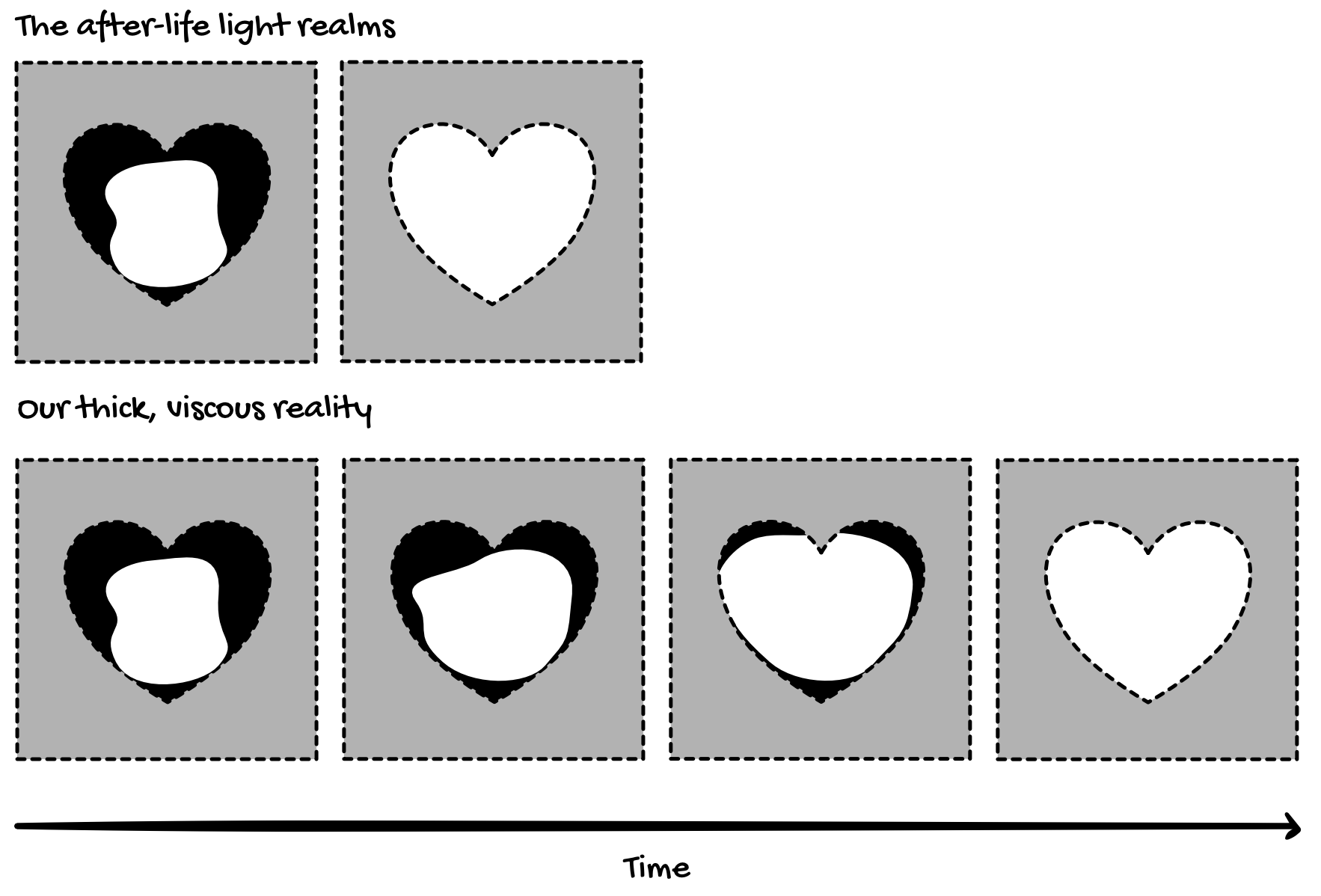The holographic and mind-created aspects of the near-death dimension are apparent in myriad of other ways. In describing the hereafter, one child said that food appeared whenever she wished for it, but there was no need to eat, an observation that underscores once again the illusory and hologramlike nature of afterlife reality. Even the symbolic language of the psyche is given "objective" form. For example, one of Whitton's subjects said that when he was introduced to a woman who was going to figure prominently in his next life, instead of appearing as a human she appeared as a shape that was half-rose, half-cobra. After being directed to figure out the meaning of the symbolism, he realized that he and the woman had been in love with one another in two other lifetimes. However, she had also twice been responsible for his death. Thus, instead of manifesting as a human, the loving and sinister elements of her character caused her to appear in a hologramlike form that better symbolized these two dramatically polar qualities.
Whitton's subject is not alone in his experience. Hazrat Inayat Khan said that when he entered a mystical state and traveled to "divine realities," the beings he encountered also occasionally appeared in half-human, half-animal forms. Like Whitton's subject, Khan discerned that these transfigurations were symbolic, and when a being appeared as part animal it was because the animal symbolized some quality the being possessed. For example, a being that had great strength might appear with the head of a lion, or a being that was unusually smart and crafty might have some of the features of a fox. Khan theorized that this is why ancient cultures, such as the Egyptian, pictured the gods that rule the afterlife realm as having animal heads.
The propensity near-death reality has for molding itself into hologramlike shapes that mirror the thoughts, desires, and symbols that populate our minds explains why Westerners tend to perceive the beings of light as Christian religious figures, why Indians perceive them as Hindu saints and deities, and so on. The plasticity of the ND realm suggests that such outward appearances may be no more or less real than the food wished into existence by the little girl mentioned above, the woman who appeared as an amalgam of a cobra and a rose, and the spectral clothing conjured into existence by the NDEer who was embarrassed at his own nakedness. This same plasticity explains the other cultural differences one finds in near-death experiences, such as why some NDEers reach the hereafter by traveling through a tunnel, some by crossing a bridge, some by going over a body of water, and some simply by walking down a road. Again it appears that in a reality created solely out of interacting thought structures, even the landscape itself is sculpted by the ideas and expectations of the experiencer.
At this juncture an important point needs to be made. As startling and foreign as the near-death realm seems, the evidence presented in this book reveals that our own level of existence may not be all that different. As we have seen, we too can access all information, it is just a little more difficult for us. We too can occasionally have personal flashforwards and come face-to-face with the phantasmal nature of time and space. And we too can sculpt and reshape our bodies, and sometimes even our reality, according to our beliefs, it just takes us a little more time and effort. [...]
In fact, it appears that this reality and the next are different in degree, but not in kind. Both are hologramlike constructs, realities that are established, as Jahn and Dunne put it, only by the interaction of consciousness with its environment. Put another way, our reality appears to be a more frozen version of the afterlife dimension. It takes a little more time for our beliefs to resculpt our bodies into things like nail-like stigmata and for the symbolic language of our psyches to manifest externally as synchronicities. But manifest they do, in a slow and inexorable river, a river whose persistent presence teaches us that we live in a universe we are only just beginning to understand.
Michael Talbot
"Okay, so there are two things I want to address here," I said. "Firstly, let's look at how our surprise-minimizing algorithm perfectly explains this data. The author of The Holographic Universe, Michael Talbot, says 'reality appears to be a more frozen version of the afterlife dimension.' If you look at this scale, you can see how that statement matches our model."

"On the left, we have pure light, love, and Truth. The more forgetful we are, the more 'frozen' our reality becomes. Forgetfulness is synonymous with resistance, contraction, fear, and separation."
"How come forgetfulness 'cools' reality down?" Zac asked.
"Do you remember this diagram from earlier in the night?"

"Yeah," Zac said.
"Each Markov-blanketed 'thing' believes they are something in particular. The more they believe that, the more resistance they create in the system. Look at the diagram and imagine that the little arrows representing resistance disappear. All the specific 'things' would begin to spread out and melt. The system would become more liquid and malleable — just like reality becomes more malleable in the light realms. Therefore, we can simplify our sliding scale to this…"

"The further you are from Truth, the thicker and more viscous reality becomes. Our realm is full of illusive fear, so we are like 'a slow and inexorable river,' as Michael Talbot said. Meanwhile, the light realms exist much closer to Truth, where all the Markov-blanketed 'souls' have remembered Who They Are. The lack of resistance in their consciousness makes their reality more like water. It can easily flow around and reshape itself.
Actually, let's compare apples to apples. Here's a short snippet about how our physical bodies manifest in the light realm."
Like Ring, after studying the testimony of his subjects Whitton concluded that the shapes and structures one perceives in the afterlife dimension are thought-forms created by the mind. "Rene Descartes' famous dictum, 'I think, therefore I am’ is never more pertinent than in the between-life state," says Whitton. "There is no experience of existence without thought.”
This was especially true when it came to the form Whitton's patients assumed in the between-life state. Several said they didn't even have a body unless they were thinking. "One man described it by saying that if he stopped thinking he was merely a cloud in an endless cloud, undifferentiated, " he observes. "But as soon as he started to think, he became himself (a state of affairs that is oddly reminiscent of the subjects in Tart's mutual hypnosis experiment who discovered they didn't have hands unless they thought them into existence). At first the bodies Whitton's subjects assumed resembled the persons they had been in their last life. But as their experience in the between-life state continued, they gradually became a kind of hologramlike composite of all of their past lives. This composite identity even had a name separate from any of the names they had used in their physical incarnations, although none of his subjects was able to pronounce it using their physical vocal cords.
What do NDEers look like when they have not constructed a hologramlike body for themselves? Many say that they were not aware of any form and were simply "themselves" or "their mind." Others have more specific impressions and describe themselves as "a cloud of colors," "a mist," "an energy pattern," or "an energy field," terms that again suggest that we are all ultimately just frequency phenomena, patterns of some unknown vibratory energy enfolded in the greater matrix of the frequency domain. [...]
Like Monroe, some NDEers report being able to see in all directions at once while in the disembodied state. After wondering what he looked like, one man said he suddenly found himself staring at his own back. Robert Sullivan, an amateur NDE researcher from Pennsylvania who specializes in NDEs by soldiers during combat, interviewed a World War II veteran who temporarily retained this ability even after he returned to his physical body. "He experienced three-hundred-sixty-degree vision while running away from a German machine-gun nest," says Sullivan. "Not only could he see ahead as he ran, but he could see the gunners trying to draw a bead on him from behind."
Michael Talbot
"So," I said, "in the light realm, souls can modify their bodies instantly using thought. Thus, it's incredibly obvious that they are getting a physical experience of their own consciousness. The observer thinks, 'I have hands.' The observed (i.e. their outer reality) instantly minimizes the surprise by manifesting hands. Thus, the observer believes 'I have hands,' and the observed generates a physical experience of that self-concept."

"Now, compare that instant surprise-minimization to our dense, viscous physical reality. When a person with Multiple Personality Disorder switches personalities, their body takes time to manifest their new self-concept. If an MPD patient instantly manifested a scar, that would create excess surprise in the system — which is why the scar takes time to manifest and then disappear again. Reality can only rearrange within the confines of mutual belief structures. Thus, this algorithm is a mathematical explanation for Michael Talbot's observation: 'it appears that in a reality created solely out of interacting thought structures, even the landscape itself is sculpted by the ideas and expectations of the experiencer.'
You can visualize the difference in viscosity with this diagram. In the light realms, reality rearranges quickly, like water. In our realm, reality rearranges slowly, like thick maple syrup taking the shape of its container."


